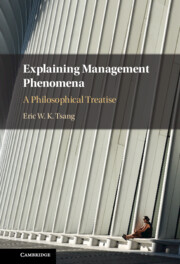Book contents
- Explaining Management Phenomena
- Explaining Management Phenomena
- Copyright page
- Contents
- Figures and Tables
- Preface
- Articles
- Chapter 1 The Nature of Explanation
- Chapter 2 Causation
- Chapter 3 Modes of Explanation
- Chapter 4 Microfoundations
- Chapter 5 Theory versus Non-theory–Based Explanation
- Chapter 6 Multi-theoretical Explanation
- Chapter 7 Research Methods
- Chapter 8 Explanation as Science (or Art?)
- Appendix Chinese Philosophy and Scientific Research
- Notes
- References
- Index
Chapter 3 - Modes of Explanation
Published online by Cambridge University Press: 15 December 2022
- Explaining Management Phenomena
- Explaining Management Phenomena
- Copyright page
- Contents
- Figures and Tables
- Preface
- Articles
- Chapter 1 The Nature of Explanation
- Chapter 2 Causation
- Chapter 3 Modes of Explanation
- Chapter 4 Microfoundations
- Chapter 5 Theory versus Non-theory–Based Explanation
- Chapter 6 Multi-theoretical Explanation
- Chapter 7 Research Methods
- Chapter 8 Explanation as Science (or Art?)
- Appendix Chinese Philosophy and Scientific Research
- Notes
- References
- Index
Summary
This chapter first introduces Aristotle’s doctrine of the four causes: material cause, formal cause, efficient cause and final cause. It is followed by the covering law model with its two versions: the deductive-nomological model, which is deterministic, and the inductive-statistical model, which is probabilistic. There are a number of counterexamples revealing the flaws of the covering law model, and the chapter discusses three: the barometer, the birth-control pill and the flagpole. A key defect of the model is that it does not involve the notion of causal mechanism. In contrast, mechanismic explanation traces the causal chain that produces the effect of interest and avoids the problems represented by the three counterexamples. Intentional explanation attempts to explain human behavior by intentional causation that treats reasons as causes. Although the terms teleological explanation and functional explanation are often used interchangeably, teleological explanation deals with conscious intent to achieve goals and is only applicable to human actions whereas functional explanation is concerned with the contribution of an entity to the future maintenance of a system of which the entity is a part. Historical explanation focuses on explaining the occurrence of some particular event by describing how it came to be. Finally, in contrast to variance theorizing that only examines the covariation among independent and dependent variables, process organization studies take time sequencing and ordering of events to be critical in conjuring up an explanation.
Keywords
- Type
- Chapter
- Information
- Explaining Management PhenomenaA Philosophical Treatise, pp. 75 - 125Publisher: Cambridge University PressPrint publication year: 2022

